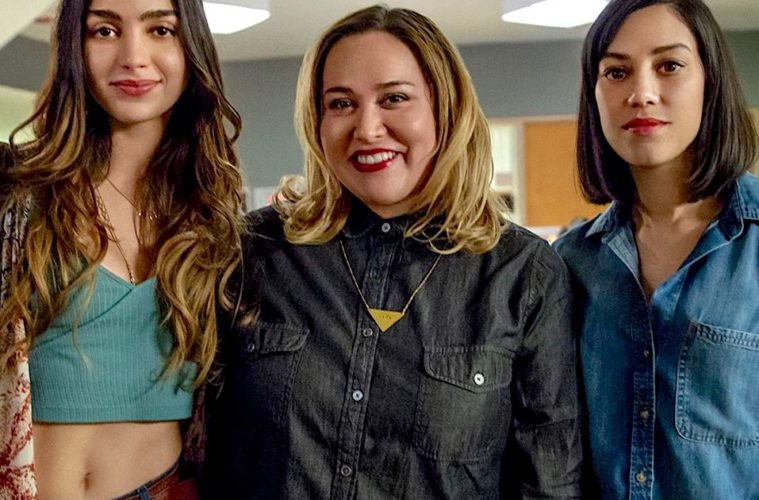When Tanya Saracho’s Vida debuted on Starz two years ago, the promo push in Los Angeles was notable. Billboards all over town depicted two hip, dark-haired young girls atop a roof overlooking the city. Would it be another TV show that sought to rep Latin culture as edgy and ended up falling into stereotypes (FX’s Mayans A.C., CW’s Jane the Virgin) or one that ignored its essence all together to use the hood as merely a colorful backdrop to insufferable avocado toast-chomping millennials (Netflix’s Love, Hulu’s Dollface)?
Thankfully — and joyfully — Vida was something truly different, and now that the show is no more (its final season ended last month, but you can still watch all three seasons on Starz) I find myself missing it and needing a re-binge. After chatting with Saracho, I feel like I need to. She created characters that were so real and complex, I actually miss them. And that’s what a great TV show does.
Vida ended too soon but it accomplished a lot in three seasons in terms of Latin/Latinx/Latine people (more about these jousting terms below). It showed the fluidity of not only sexuality but of identity itself. As people of color — and varying shades of color — know only too well, especially right now, acceptance can waver depending on one’s environment, company kept and how the outside world perceives one’s ethnicity. Vida sought to explore these truths and nuances in a real way and it more than succeeded.
The show’s premise is pretty simple. Two sisters, Lyn (Melissa Barrera) and Emma (Mishel Prada) Hernandez, return to the Boyle Heights neighborhood where they grew up after their bar-owner mother passes away. As in real life, the neighborhood is in the midst of both gentrification and “gente-fication” (the changing, upscaling or white-washing of a community by its own people) and the ladies attempts to make the bar a viable business is seen as part of the problem. The dispute between local activists and the new bar owners, not to mention the bar’s older regulars, provides the backdrop for the show, but it’s the interpersonal relationships that make Vida‘s heart beat with realness and rhythm.
Lyn uses sex to get what she wants for the most part but she’s clearly looking for true love, while Emma eschews labels when it comes to her sexuality, but closes herself off to real emotional bonds, most likely because her mother didn’t appear to accept that she was bi-sexual as a young girl, but years later married a woman herself, big-hearted bar regular Eddy (Ser Anzoategui). We see a little less of the brilliant Anzoategui in season 3, but their moments on screen highlight some very contemporary generational contrasts that affect queer culture (an episode featuring drag kings is particularly strong). Season 3 also features a gay quincenera, an adult baptism, a psychedelic molly trip and plenty of erotic scenes of all stripes — and straps — in bedrooms/bathrooms/rooftops, a signature of the show.
Saracho talked about the sex, the city, the Spanglish and the unforgettable stamp she left on cable television when it comes to “Latinx” stories by phone just after the final episode aired a few weeks ago.
L.A. WEEKLY: First things first! Let’s talk about Vida‘s ending. I loved this show so much and I would have been sad to see it end no matter how you did it. But the final episode left me a little frustrated, and with so many questions!
TANYA SARACHO: Yeah. Some people have said like it’s like an indie ending or like a cinematic ending — what happens? And I’m like, good! Good! You fill in the blank. The ending took me a while. You know how you go do the pitch to the network and you tell them everything you’re going to do this season? In my PowerPoint presentation, I left the speech empty and I said, ‘you’ll see, or something.’ I forgot what I put.
And they were like, well, how does it end? I just said, ‘No, you’ll see, you’ll have an ending.’ It was a few months until we knew the ending. You don’t need it just now. I don’t need it just now. I didn’t want to know, you know? I always have a set image in my mind. I always had the image since I wrote the pilot of what would happen, but I didn’t know how to get there. And then we turned in the outline and there was no last scene and Starz was like, ‘well what’s going to happen?’ I’m like, hold on! I’m getting there! Holistically I needed to get there, you know? And then finally when we had a script, they got it. And they [were] still like, ‘so what happens? Wait, that’s that happens?’ Yes, they do that and walk off.
I wanted to know their entire futures… like with a flash-forward or something. But maybe we needed to wonder. Maybe that was the point. Life — and of course Vida means life in Spanish — is like that I guess. What kind of responses are you getting?
It’s complex, the show. And you never get a real resolution to things. An epic night might be decided but it might not resolve anything. This is like that. The circle you know has been like this. I guess the endings have been active — in that the first ending of the first season, it was like, let’s do this, and then they do, and then the second season it was like, ‘we’re good.’ The sisters are good. But it’s more definitive.
The ending to the whole show… I don’t know. You get a lot of clues, if you [look at] the last scene for every character. If you believe Johnny and Mari, you know what happens to that relationship now. They’re going to be more equal, you know. If you believe Johnny and Lyn’s scene, they’re going to try to give their romance a go. And I happen to believe they will. Mari has pivoted to the path that she should be on too. And my darling Eddy. We end on a positive note, and I’m glad because man, that character had not had many breaks for three seasons.
But are they going to sell the bar? Or are they going to stick with it? I wanted to know that.
I know you do! I think in our mind, hopefully the story can keep going since it can’t happen on TV. This is more like, what if we looked back at them five years from now and looked back at what happened. I always knew what the ending would look like and was lucky enough to get to direct it. I didn’t know when I thought of that image of them walking towards the bar, I didn’t know that I was going to be a director by then and get to do it myself and think about about crane shots and stuff like that. But we got there and I think I still it would have gotten there in a similar way.
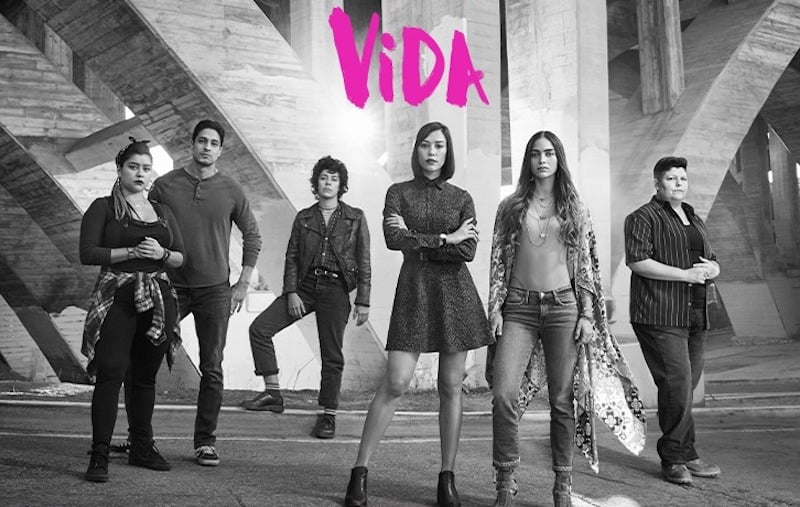
The cast of VIDA. (Starz)
Is there any chance the show could be brought back?
To me, they told us, “no chance.” I know my cast is holding out hope. I just have had to make peace with it and now I’m in the acceptance phase. I’m so grateful I got to do three seasons of a story that I didn’t have to compromise on and I got to tell the story I wanted to tell. Truly, the colors, all the colors I wanted to use are there. All of the sounds and the tastes… what a gift. And now I’m sitting here in corona times being like, ‘will I ever get to do it again?’ Because we’re all sitting here thinking that. It’s not just me. But I’ve been blessed that I was able to do it and also I would never be able to do something like Vida, the next five years because how am I going to have actors doing the sex scenes that I had them doing during coronavirus times? There’s no way. Vida is a period piece now.
How did the coronavirus affect your last few shows? Did you have to rewrite anything?
No. We were editing. March 12 I delivered Vida. March 13, I went into quarantine. Thankfully we were in the end of the editing process. I started wearing a mask the week before and people were making fun of me at work, the editors and stuff. I was wearing gloves and I was not touching people. Usually we have champagne and food after filming and I didn’t touch it. I did not hug a single person. I was like, ‘no you guys,’ and they thought, ‘she’s taking this too far.’ Guess what, we got locked down in L.A. soon after. I don’t know why people weren’t paying attention. So thank goddess I got to turn it in the day before I went into quarantine.
So it didn’t affect the finished product?
No. One of the effects of it is like, you know, really good press. We didn’t get that and we didn’t have a premiere and the meaningful part of having a premiere is not like the big party, but getting to see everybody and say thank you and say goodbye. I didn’t get to hug anybody goodbye. I didn’t have a ritual to this, this big experience in my life, to thank each cast member. It’s not the same on Zoom or on Facetime. My editors were going to come, my writers, everybody was going to come. But that didn’t happen. That’s the stuff that got affected. And I know that affects the cast a lot because they really, truly, not a joke, they love each other. They’re like family. I think they’re going to be friends forever, most of them.
That connection between the actors really shines through.
The two sisters really became sisters. Like, they love each other. And it’s never a false note. It’s real, their love for each other.
The show takes place in Boyle Heights. Were you actually filming the bar scenes in Vida there?
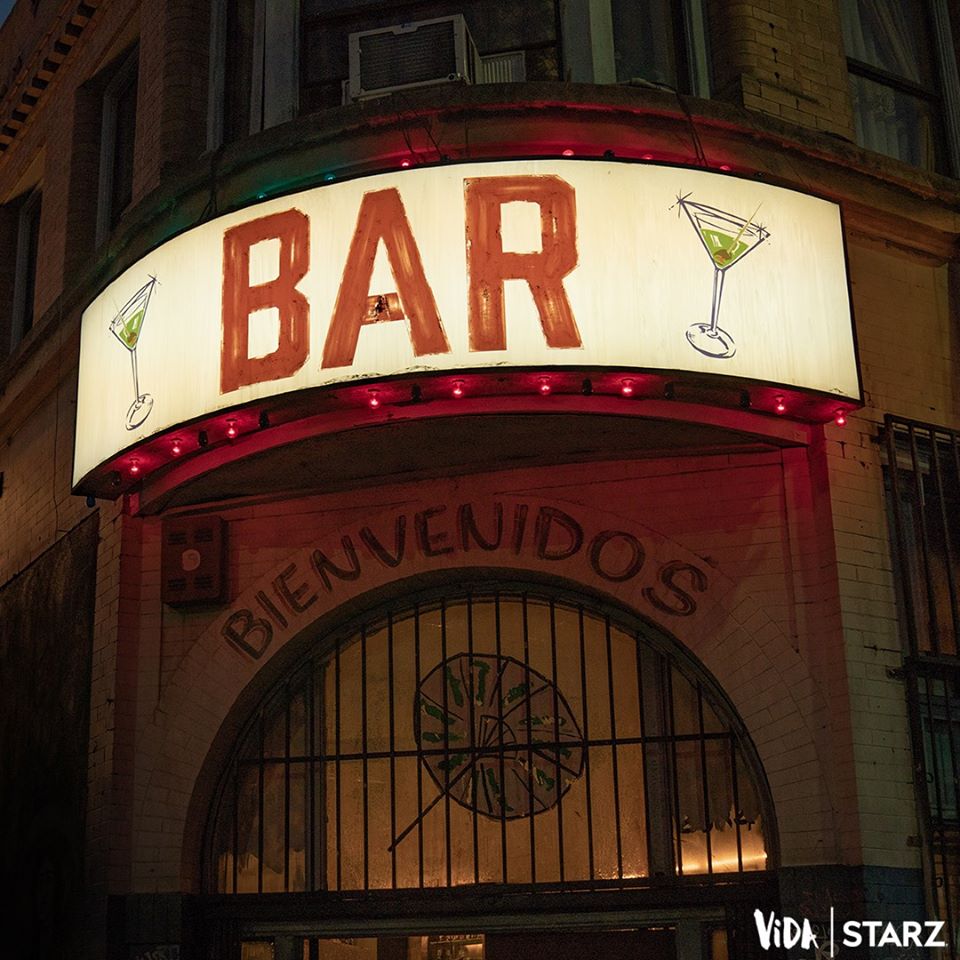
The exterior of la VIDA bar. (Starz)
That’s Pico Union because we shot all of the pilot presentation in Boyle Heights but we got protested by some organizations, some neighborhood organizations. And I took that very seriously because it’s a show about gentrification and we were sort of gentrifying with a Hollywood truck. I took over a street, a block, and we had a base camp. So I said we have to shoot in Boyle Heights. This is about Boyle Heights. We have to do it. But how can we do it? Pico and Union kind of feels like it with the trees and the stores. We knew we were going to be in that intersection so much. So we didn’t want to occupy, to occupy it with our stuff as much. But we did have to do a fair amount of shooting, especially with exteriors, and Mari’s house is like smack in the middle of residential Boyle Heights. The mechanic shop is like right there, too. And of course when we shoot in Mariachi Plaza and stuff like that we have to go there, but we were so respectful.
We shot this ICE detention scene where we had to sort of do different kinds of camera work around the neighborhood that maybe we would have to do for another scene. It’s a triggering thing to this neighborhood, this imagery of ICE agents ripping a man from his car, a child nearby. So we were just extra careful. We were very aware of where we were.
Where was the bar?
Yeah that was in a 99 Cents Store we turned into a bar for season 1. If you pass by, there’s no bar, it’s just a 99 Cents store now. But then season 2, the interiors we shot at CBS, but the exteriors was at that 99 Cents place. And that corner allowed us use of their spaces for background and so we were able to change the facade and make it into the growing neighborhood, because the neighborhood changes. It’s being gentrified every season, so every corner gets gentrified in a different way. I love that corner. I’ve walked that corner so much. I know where every tree is, the bench to wait for the bus, it’s so familiar to me now.
Let’s talk about the show’s attitudes and depictions of sex. What did you envision?
Well I want to show sex that’s as true to life as we can, meaning the feeling of it. The purpose for it. I do have a lot of respect for sex, but in a good way, meaning I understand that it’s for power. Negotiating power, giving up power, taking power, that’s what sex is. Like Lyn — Lyn gives up power in order to get power. She gives up power by becoming whatever you need her to become so that she gets power. There’s no gratuitous sex scenes. Everything is purposeful to show psyche or a character’s psychology or how the play. Or as a mechanism, like for Emma it’s mostly that. But it’s also power, especially because she has sex with not just males. You see her have sex with non-binary people and it becomes a little different, a little softer. You see her have sex with women and she actually becomes a bottom sometimes. Mapping Emma’s sexuality through who she’s having sex with, it was important to us.
Vida showed a lot of fluidity in context of Latin culture, which is usually fairly conservative. Did you find that older Latin people were offended by some of Vida‘s content and did you think about, like how your own family might react to the explicit stuff?
I am a queer Latina, half my writers are queer Latinas and the cast, we know this. We know this about our community. The first season I saw language, just in comments and Twitter, mostly Latino males who were commenting on that I hate men or something. Maybe it’s the algorithm or I just haven’t seen that that much. I know my own mother could only watch the first episode. She’s never seen the rest of the thing. So I get it and there’s tias I would not share my show with just because, yeah, I can’t even.
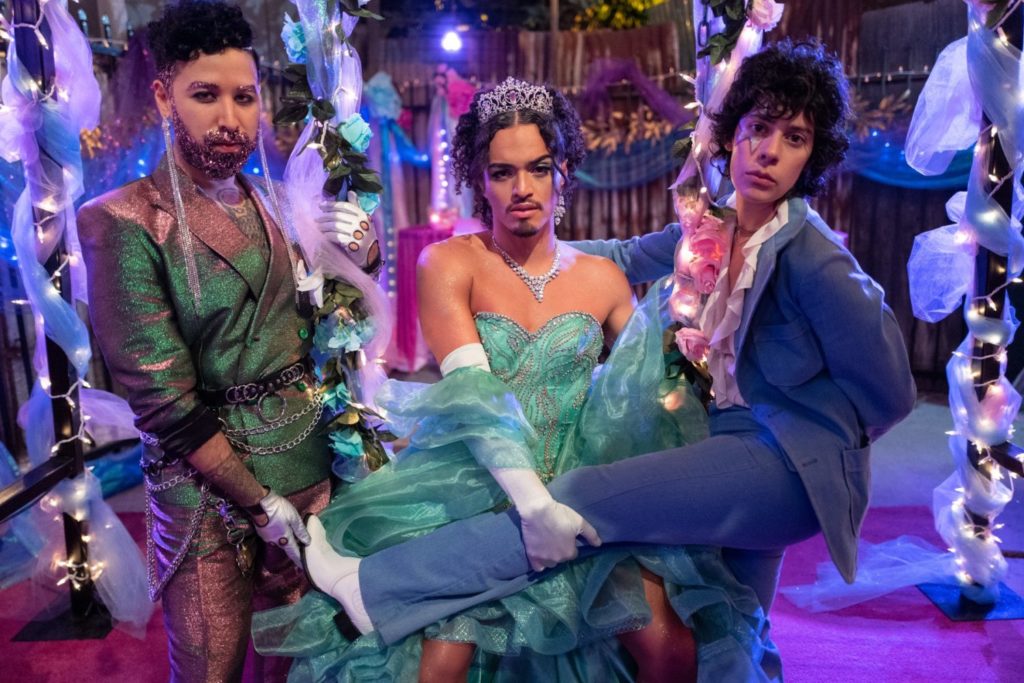
VIDA’s epic queer quince. (Starz)
The show is so well done, I hope it opened some closed minds. You show our culture so authentically and you show different lifestyles within the culture, which is important even if older Latin people don’t wan’t to know.
I’m showing these people in a true-to-life way. Millennials don’t wear condoms all the time like maybe our generation did. There are things that are real about this generation that we’re depicting that is all — one part is not divorced from the other. So I am happy how we did it and how we got to do it. It feels true to life. Either from my own life or from a writer’s life, every sex scene was- it happened to someone. Whether we did it in the bathroom or we did it on the stairs, it was all real.
Let’s talk a little more about generational differences. As a Gen-X Latina woman, I have to admit, I have never been able to get with the term “Latinx.” It’s everywhere, especially in media. Vida called itself a “Latinx” show. Have you gotten any negative feedback from older Latin and Mexican people like me?
Yes, I have. I’ve gotten pushback. But what do you call Ser? How do you define them?
I interviewed Ser — my favorite character on the show, by the way — and referred to them with non-gender identifying pronouns throughout the story. And I used “Latinx” in the headline for the piece because that was how it was branded. I’m not against people identifying that way and I get that “Latina” and “Latino” or “Chicana” and “Chicano” indicate gender, which is restrictive and limited. But I think it’s become a trendy blanket term, and it feels like some are trying too hard to be P.C. when they use it as a descriptor sometimes.
They are. I encourage it, though. Listen, if we say the plural of Latin, you would probably say Latinos, right? You would use the masculine, so that’s not cool with me. And actually, there’s a new term. It is going to be Latine, with e at the end. That’s what we’re moving towards. It’s the same as Latinx, but it’s harder to say Latinx. So you can see Latine, Chincane, chices.
I like that better. Do you think that’s something that people will use more?
I know that when I came in three and a half years ago to Starz I was like, this [“Latinx”] is the term we’re using. So in every press release, especially because we have sex, we have to utilize that term. And I’m so happy that they did it. I hope that we shift to Latine because it’s easier and I hope it stays. It’s not just about how hard it is with the “x.” What I found is many people [are not able] to acknowledge a nonbinary identity and that is really disappointing in this community. That’s what it ends up being about. So that’s why I use it. There was a big speech the first time we shot and introduced Ser. We had a bunch of trans people, too, that worked on the show. We used our preferred term and made it clear this was going to be that kind of set, you know? That we see each other, truly. So that’s why I fight for Latinx because I do believe in seeing people. But I get it. I understand your take.
As for Latine. I don’t know who you follow on Instagram, but start paying attention to the activists and thinkers and academics that use Spanglish. They’re using Latine, Chicane, y chices, hermanes, “e” instead of “o,” saying hermanos. In greetings mostly, addresses. I hope it does change but I know I just got Starz to do Latinx so that’s a step too.
What are you working on next?
There’s a lot of stuff on pause because of the ‘rona, so I do not have answers for anything. I want to direct a movie, so I want to write and direct a movie with Big Beach, the production company that did Vida. They also do The Farewell. I’m pivoting just a little bit to film even though I’ve never done it. Especially because that’s something I can sit here and write.
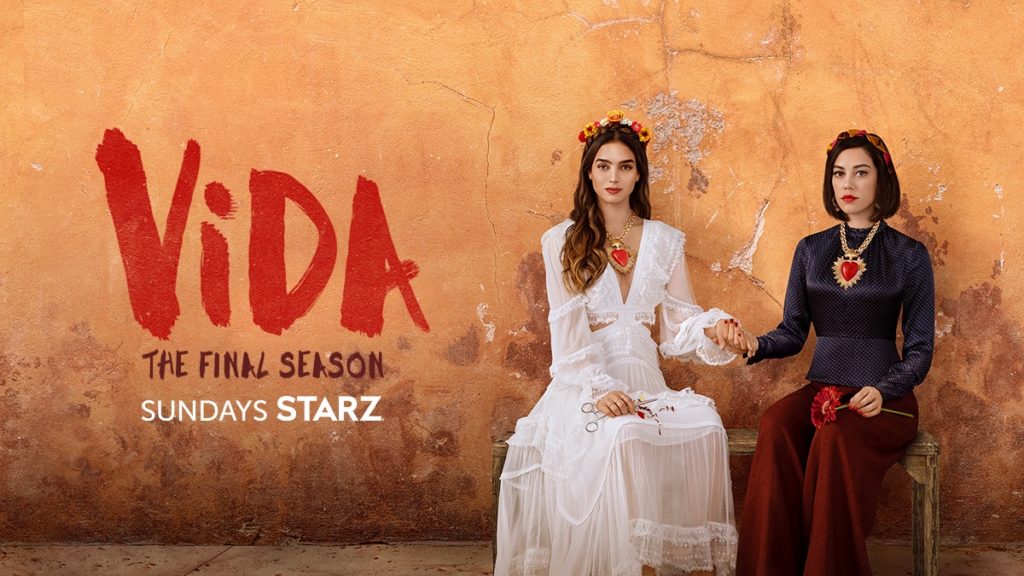
VIDA final season promo. (Starz)
Vida was your first show right?
Yes, absolutely. First. Primerizo. First baby.
So if you move to films, where do you want to go with your career and what kinds of stories do you want to tell? You started directing too right?
I feel like we can do it all, maybe. The directing bug hit me, especially that last episode. I loved it. I loved directing that quinceañera too. I was like, I need to do this more. I want to do it in a concentrated way. I guess in film the director, it’s like, this is their vision. And then if I get to write it, I can really share it. So there’s a lot of esoteric thinking happening over here without any concrete plans.
Do you think you’ll want to always tell stories that reflect Latinx people and or LGBTQ?
Because my queerness fits in the spectrum, I could see myself doing a hetero project. I don’t have one right now but I could see that happening. My next two things are, they got queerness in there. It’s like Vida, which is not just a queer show. There’s just people in it and a big percent of them happen to be queer. But it will always be Latinx themed. That’s my mission here. I am here for that. Even if it’s one character for the main point of view. Below the line, I got to give us opportunities. The Latinidad I think is always going to be there. And I don’t feel limited by it. I have this argument with my dear friend who’s a show editor and Cuban and sometimes he feels limited by- they only send him Latinx stuff. [He says] ‘I can do other stuff, I don’t want to be pigeonholed.’ And I feel the opposite. I feel empowered. We are so many peoples- meaning countries, cultures, subcultures, I’ll never run out of stories. So yeah, I don’t feel limited.
I am doing these conversations with LGBTQ+ game-changers like yourself for Pride Month. Have you participated in Pride in the past? Why do you think it is an important thing to highlight?
I think Pride is awesome. I belonged to the queer theater company in Chicago, because I was in Chicago for 16 years. And I would participate. Usually I was working Pride, like I would do the booth for About Face- that’s the name of the theater company. But I was not prepared for the intensity and size of LA Pride. It’s massive and I live near West Hollywood, so it was like, oh! I never went to LA Pride since I moved here and 2015 is when I formally moved here. But last year, last June, [Vida’s cast] were the grand marshals for San Francisco Pride. And I wore the rainbow. The dress was extra and there was like a Frida Kahlo flower thing on my head. It was really cool.
Advertising disclosure: We may receive compensation for some of the links in our stories. Thank you for supporting LA Weekly and our advertisers.

